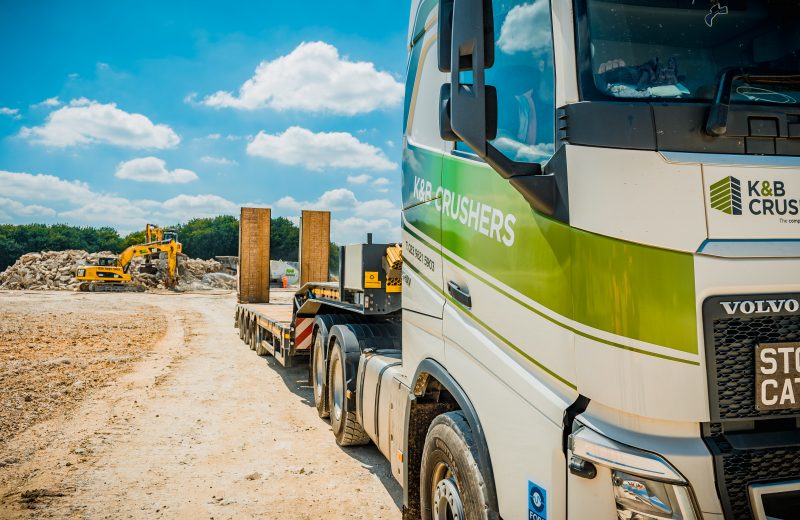Before understanding recycled concrete uses, it’s important to gain an insight into the importance, benefits and methods of recycling concrete.
While crushing equipment is primarily used in the processing of virgin materials, it is also incredibly important for the recycling of concrete and other materials.
In this article, we’ll be discussing how the construction industry can make sustainable changes to improve the recycling of building materials, as well as the methods of recycling concrete and recycled concrete uses.
Designing recycled construction materials for less waste
With building demolitions responsible for a huge amount of waste, it’s understandable how attention has been turned to working out how we can make a difference. Unfortunately, thus far, we’ve been following an outdated approach known as ‘linear economy’, where materials enter one end and exit out that same single spot – take, make and then throw away.
Recycling materials may be the answer to our waste management problem in theory, but it is far from perfect. Inefficiencies lead to only 5-30% of viable outputs compared with total waste input – meaning we can’t use recycling alone as a sustainable solution. Even materials like sand are being strained by growing demand, proving that this crisis requires much more.
The key principles of recycling building materials
When we look to navigate the complexities of construction as a whole and consider what’s involved in often transforming raw materials into a functioning building – taking those materials and reusing them is no straightforward task.
To help consider how this can be the most effective, we’ll take an in-depth look at some key fundamentals and principles below.
1. Using fewer resources
Making use of waste can have a massive impact on helping us meet carbon reduction targets. When it comes to recycling, though, the efficiency isn’t quite there yet. Mixed material sorting typically yields between 5-10% efficiency — whereas separated materials yield much better at 10-25%. This is due to material composites, poor sorting and contamination.
In short, we need sustainable product design and financial incentives for more effective reuse efforts if we want to see meaningful results from these initiatives.
2. Using resources for longer
We can ensure our buildings will last for years by designing them with longevity and reparability in mind. With the help of 3D printing, prefabrication, BIM technology and modular building components, buildings can be designed with elements that are more easily reused, repaired and recycled.
3. Using resources again
Recycling building materials can be a challenge but, if done right, can have huge benefits. Steel, glass and plasterboard are highly recyclable – nearly all structural steel (98%) is diverted from landfill while 70% of rebar used in concrete reinforcement gets recycled when separated properly.
Planning ahead when removing plasterboard allows it to be infinitely recycled – if kept whole. By opting to recycle plasterboard, the need to mine more of the soft gypsum sulphate mineral (used in many forms of plasterboard) can be reduced.
4. Using clean resources
With offsite, modular construction, builders now have access to a greater range of sustainable building materials such as timber. This material is largely used for structural elements in buildings. The best part? It can last up to a hundred years – and what’s more: it absorbs carbon emissions during this time around which helps lower the embodied carbon of the overall project.
Bamboo, an amazing natural resource, is also becoming increasingly popular. This fast-growing plant can shoot up 3ft in a single day while also cleaning our air of carbon. However, while it has a higher tensile strength than steel, this incredible material has one noticeable drawback: it’s prone to natural degradation over time.
How recycled concrete is changing construction
Crushing equipment plays an important role in both the processing and recycling of materials. Whether it be limestone, basalt, granite or other stone that’s mined. Many don’t realise how useful crushing equipment is for both the original crushing of materials, and their recycling.
In fact, this crushing equipment is what effectively enables the recycling of materials such as asphalt and concrete.
How traditional concrete and asphalt are disposed of
Traditionally, when materials such as concrete and asphalt are removed, they often end up in landfills. Although a relatively simple approach, this resulted in landfills being filled much faster, as well as freight costs.
Recycling concrete and asphalt has allowed these materials to be reused, avoiding a huge impact on landfills – and the environment. In the early days of recycling, reuse was almost primarily as a fill product, due to quality issues and gradation irregularity.
Today, recycled concrete and asphalt can be crushed, resulting in a range of recycled concrete uses.
Concrete recycling
Recycling concrete is an efficient and cost-effective way to break down demolished materials – such as sidewalks, columns or foundations. The process involves breaking and removing the material before crushing it into a specified size and quality – not dissimilar to the process of crushing virgin materials. Plus, using portable cutting rigs on-site can further reduce expenses.
Crushing concrete is now more precise and efficient than ever, thanks to advances in equipment and technology. These new resources now support a broader range of concrete, for more efficient recycling. With the right equipment available, steel remnants can be removed with less manual labour, while a range of materials from jointed plain pavement to continuously reinforced pavement can be appropriately crushed.
Once crushed – how are these materials used? Although often used as a sub-base – one of many recycled concrete uses – it can also be used as an aggregate for new concrete.
Asphalt recycling
The process of recycling asphalt is similar to traditional crushing methods. The old material – often removed from roads and car parks – is broken down into chips and stored. Once crushed, it is often used as a chalk mix to replace what has been removed.
Asphalt recycling, however, is becoming increasingly more common in the U.S. According to the Federal Highway Administration, over 80% of the asphalt removed from roads is recycled.
Recycled concrete uses
Concrete aggregate is a versatile and sustainable building material – it’s perfect for almost any project that requires concrete, concrete asphalt or aggregate, from residential, and commercial structures and some industrial applications, including:
- Landscaping – One of many popular recycled concrete uses, this may involve the construction of retaining walls, flower beds and even drainage systems
- Construction projects – Recycled aggregate is frequently used for engineered structural fill and embankments, as well as a sub-base material for foundations, driveways and carparks
- Road repairs, as well as public pathways and pavements
- Environmental restoration projects
Speak to us today about concrete crushing, recycling and recycled concrete uses. With over 25 years of experience in the industry, K&B crushers are well-placed to provide cost-effective recycling across the whole of the UK.



